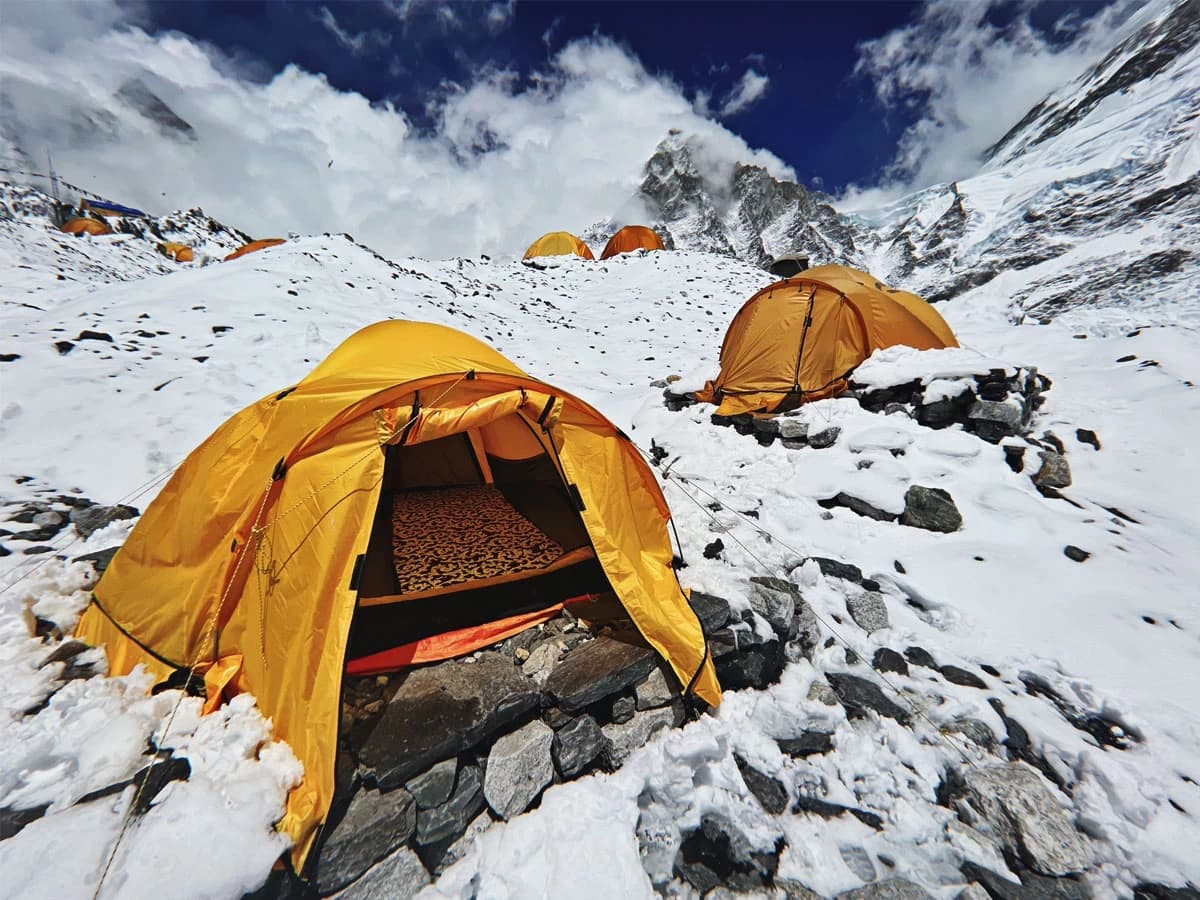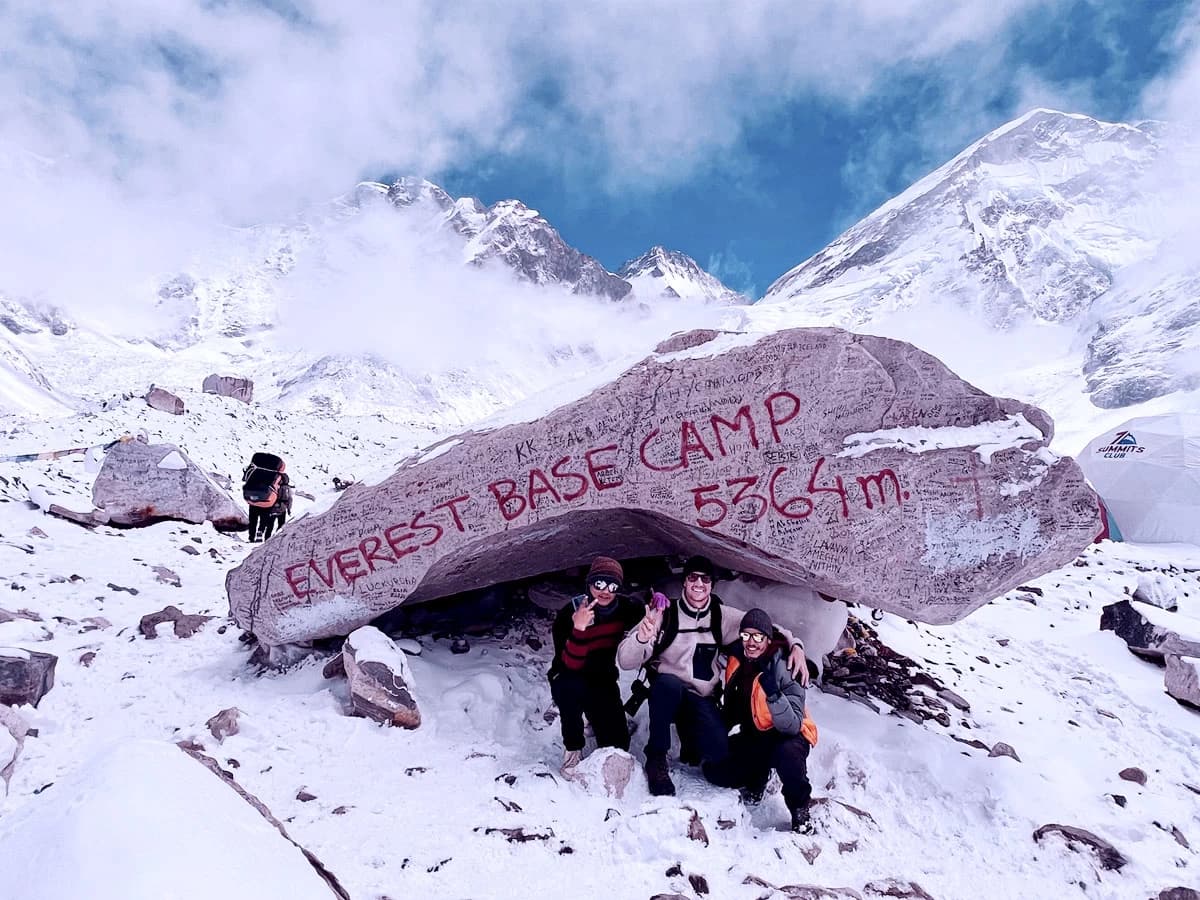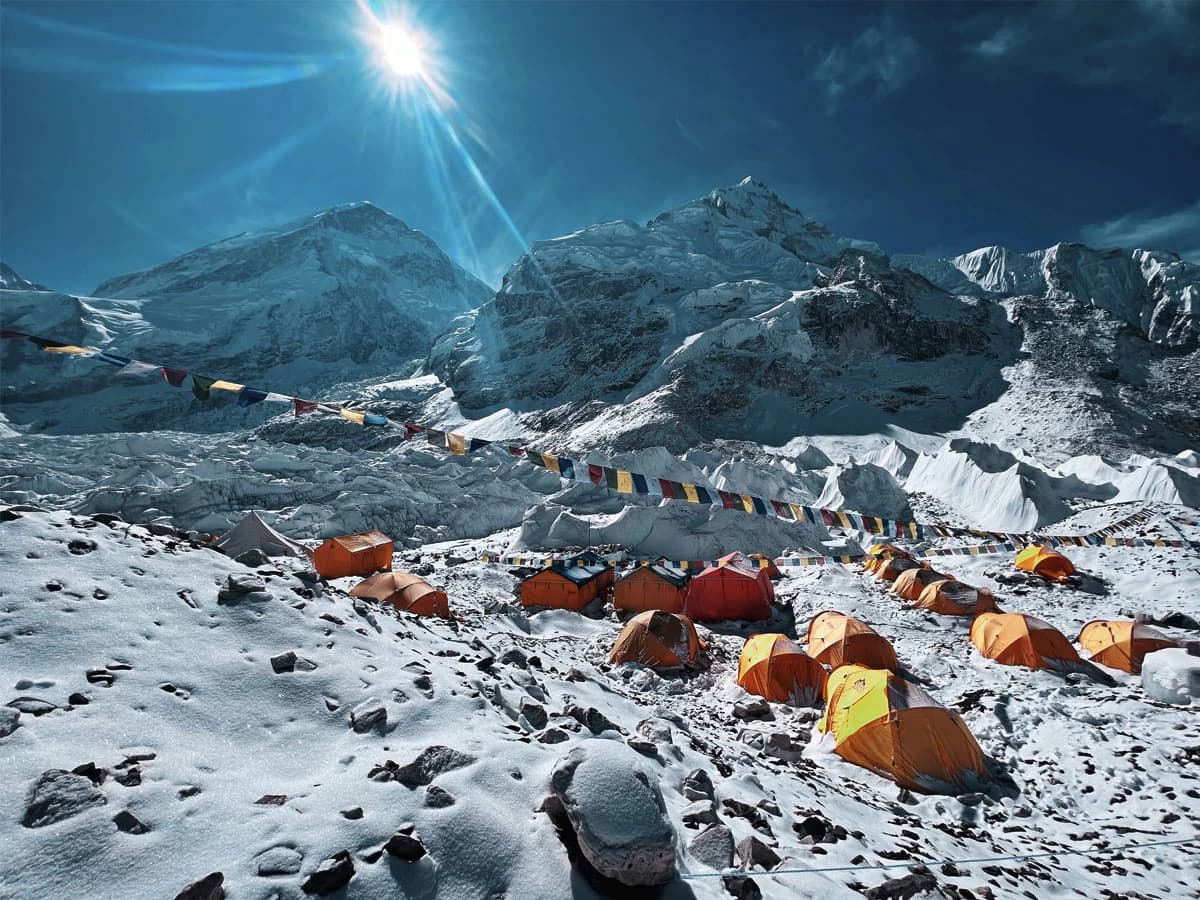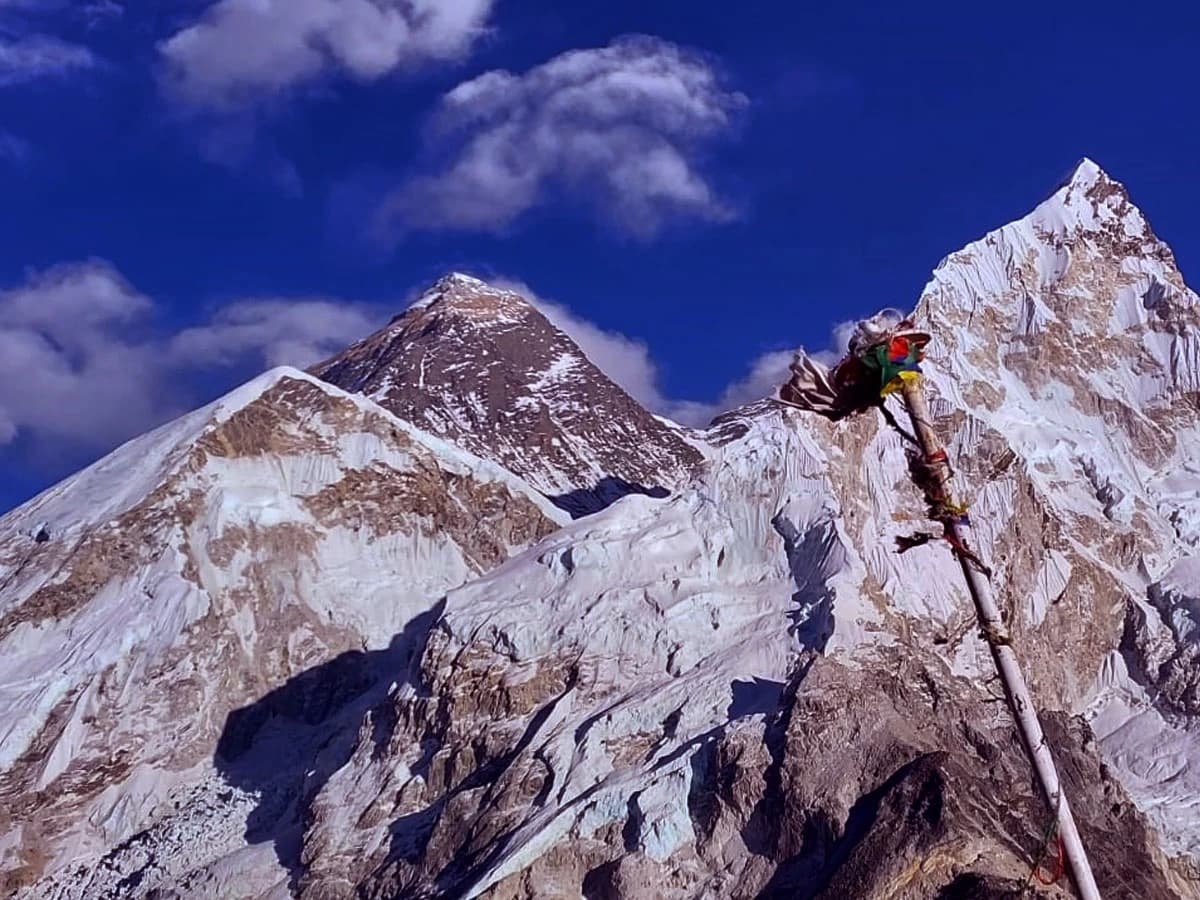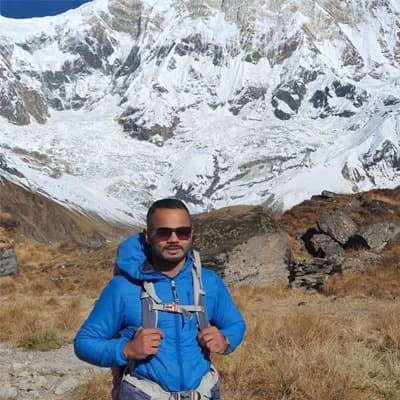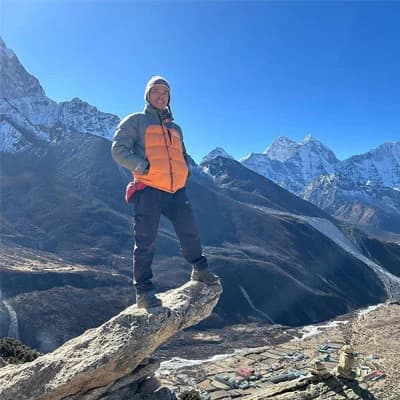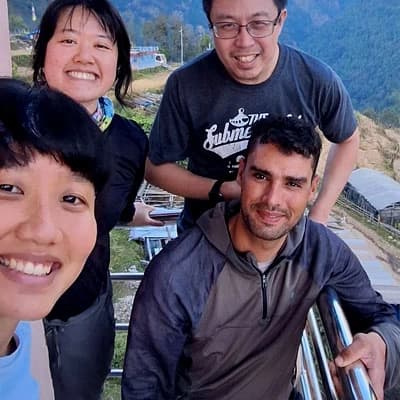The Sleeping at Everest Base Camp Trek takes you along the 65 km-long Everest trail and concludes with an overnight in a tented camp at Everest Base Camp (5,364 meters / 17,598 ft). This incredible journey takes you through the stunning Khumbu Valley, where you’ll immerse yourself in Sherpa culture and witness the breathtaking Himalayas. Most importantly, you will get a glimpse of the mountaineer’s life, resting at the very spot where climbers prepare for their Everest ascent.
Sleeping at Everest Base Camp Trek
Highlights
- Experience the thrill of reaching Everest Base Camp, the base of the world’s tallest peak, Mt. Everest (5,364 m).
- Enjoy a scenic flight between Kathmandu and Lukla, offering aerial views of the Himalayas.
- Visit the spiritual Tengboche Monastery, surrounded by spectacular mountain views and rich Sherpa culture.
- Explore Sagarmatha National Park, home to diverse wildlife and the famous Khumbu Glacier.
- Spend a night at the base of mighty Mt. Everest surrounded by other majestic peaks.
- Witness the panoramic views of Everest and nearby peaks from Kala Patthar, one of the highest viewpoints on the trek.
- Immerse yourself in Sherpa culture by exploring traditional villages, interacting with locals, and learning about their unique customs.
- Walk through varied landscapes, including glacial moraines, lush forests, and serene valleys filled with prayer flags and mani stones.
Overview
Picture yourself flying above the Himalayas, with snow-capped peaks stretching endlessly beneath your plane. Soon, you land in Lukla, the gateway to the Everest region, marking the beginning of your Everest Base Camp Overnight Trek.
From here, your hike will lead you through enchanting Sherpa villages and across gently swaying suspension bridges, gradually ascending to the vibrant Namche Bazaar, a bustling hub of culture and activity.
After acclimatizing in Namche, the journey continues to Tengboche, home to the peaceful Tengboche Monastery, nestled among towering peaks. As you trek further, you’ll experience stunning views and reach the high-altitude Everest Base Camp.
Plus, this part of your journey is truly fulfilling. You will have the unique opportunity to stay overnight at the foot of Mount Everest, making it a memorable Everest Trek with Overnight at EBC experience.
In addition to this, from Gorakshep, you will hike to Kala Patthar. This trek rewards you with panoramic views of Mount Everest and the surrounding Himalayan giants while marking the highlight of your adventure.
Sleeping at Everest Base Camp Trek Itinerary
Welcome to Nepal. Once you arrive at Kathmandu airport, you’ll go through luggage checks and complete your on-arrival visa process if needed. Don’t worry, the process is simple, and help is always available.
After that, a representative from Himalayan Massif Trek will greet you at the airport. They will assist you with your transfer to the hotel, where you can settle in and relax. Since you might feel tired from your journey, taking the day to rest is a great idea. It’s the perfect way to prepare for the exciting adventures ahead.
Today, you’ll take a stunning 30-minute flight from Kathmandu to Lukla Airport, located at an altitude of 2,846 meters. During peak trekking seasons, flights may operate from Ramechap Airport instead. If so, we’ll arrange a private vehicle for the 4-hour drive to Ramechap.
Upon arriving in Lukla, your trek begins. You’ll walk through lush trails surrounded by greenery as you head to the village of Phakding. This 4-hour hike is a gentle introduction to your adventure, offering a glimpse of the natural beauty of the Khumbu region.
After a hearty breakfast in Phakding, you’ll set out for Namche Bazaar, a bustling mountain town and the gateway to the Everest region. The trail leads you through beautiful villages, and into Monjo, where you’ll officially enter Sagarmatha National Park. As you continue, the climb becomes steeper, and you’ll cross thrilling suspension bridges adorned with colorful prayer flags fluttering in the breeze.
Arriving in Namche Bazaar is a rewarding experience after the steady ascent. You can unwind and enjoy incredible views or stroll through the vibrant streets of this Sherpa hub if you feel up to it. If not, don’t worry - you’ll have plenty of time to explore and acclimatize the following day.
Today is all about resting and adjusting to the higher altitude, but that doesn’t mean the day will lack adventure. You can hike to nearby villages like Khunde and Khumjung, which offer beautiful views and a chance to immerse yourself in the local culture. A short trek to the Everest View Hotel is also a great option, where you’ll be rewarded with amazing vistas of the Everest region.
In Khumjung, you can visit the famous monastery that holds what is believed to be the skull of a Yeti. There’s also an art gallery displaying an interpretation of the mythical creature’s appearance. Don’t miss a visit to Khumjung Secondary School, a project founded by Sir Edmund Hillary, to learn about the region’s history and education. These activities make your rest day both enjoyable and meaningful.
Your journey to Deboche begins with an incline to Kenjoma, followed by a challenging uphill climb to Tengboche. Tengboche is home to the famous Tengboche Monastery, a spiritual highlight of the region. From here, you’ll enjoy clear views of iconic peaks like Ama Dablam and Everest, making the effort worthwhile.
The path from Tengboche to Deboche is more relaxed, with a gentle downhill walk. Once you reach Deboche, you’ll be welcomed by beautiful views of towering peaks like Nuptse, Kantega, and Thamserku, making it a peaceful spot to rest for the night.
Today, you’ll embark on a 13-kilometer trek to Dingboche, which takes about 7 hours. The trail begins with a descent into the Imja Khola Valley, followed by a steady climb to the village of Pangboche. Along the way, you'll enjoy beautiful views of the surrounding mountains throughout the day.
Dingboche is an enchanting village nestled among stunning mountain peaks. While you won't have a direct view of Everest from here, you'll be surrounded by other magnificent mountains like Island Peak, and Ama Dablam.
Today, you’ll set out on an acclimatization hike to Nangkartshang Peak, which stands at an altitude of 5,083 meters. The 5-kilometer round-trip hike takes around 4-5 hours and offers incredible views of the Khumbu region’s majestic peaks, including Tawache, Pumori, Everest, Lhotse, and Island Peak. This hike not only helps your body adjust to the altitude but also provides an unforgettable experience of being surrounded by soaring mountains.
If time and energy allow, you can also visit Chhukung, a lovely spot for viewing Mount Makalu. After completing the hike, you’ll return to Dingboche, where you’ll spend another peaceful night, ready for the journey ahead.
On Day 8 of your exciting Everest Base Camp adventure, you'll embark on a five-hour hike from Dingboche to Lobuche. After enjoying a delicious breakfast in Dingboche, you'll set off on your trek. Along the way, you'll pass through Pheriche, a village nestled high in the mountains.
From Thugla, the trail ascends steeply toward Lobuche. This climb can feel challenging due to the thinner air at higher altitudes, but the reward is worth it. Upon reaching Lobuche, you’ll be greeted with views of the Khumbu Glacier, Nuptse, and Tawache. This peaceful mountain village marks another step closer to your ultimate goal, Everest Base Camp.
On this day, you’ll trek from Lobuche to Gorak Shep, a unique village high in the mountains. The hike covers about 7 kilometers and usually takes 3 to 4 hours. The trail can be tough, with high altitude and rocky paths, so it’s important to walk slowly, take breaks, and stay hydrated. After arriving at Gorak Shep, you’ll enjoy a hearty lunch to recharge.
In the afternoon, depending on your plan, you can hike to either Everest Base Camp or Kala Patthar. The trail will bring you closer to the Khumbu Glacier, offering stunning views. One of the highlights of this trek is crossing a frozen lakebed – a truly unforgettable experience. Afterward, you’ll rest at a teahouse in Gorak Shep, preparing for the next part of your journey.
After breakfast at Gorak Shep, you'll first trek to Kala Patthar. This 2-hour hike will bring you to one of the best viewpoints of Mount Everest, where you can enjoy stunning panoramic views of the surrounding peaks. Kala Patthar is famous for its breathtaking sunrise views, and today you'll capture unforgettable photos of Everest and the Khumbu region.
Once you've explored Kala Patthar, you’ll continue your journey to Everest Base Camp. This final stretch takes about 1-3 hours, depending on the pace, and brings you closer to the Khumbu Glacier. Upon reaching Everest Base Camp, you'll rest in a cozy tent with a warm sleeping bag and enjoy a meal for a comfortable overnight stay at the foot of Everest.
Today, you'll start your journey back to Pheriche, passing through Gorak Shep and Lobuche. The trek covers 13 kilometers and usually takes about 5 to 6 hours. The path begins with a descent from Gorak Shep, making your way toward Lobuche at a slow and steady pace.
Once you reach Lobuche, you'll continue the descent to Pheriche, where you'll spend the night. The day’s hike offers a more relaxing pace, giving you time to enjoy the changing landscapes as you move closer to lower altitudes.
Today’s trek takes about 6 to 7 hours, with a descent of almost 1000 meters. The path has some rocky sections and ups and downs, but the views are worth it. If you're lucky, you may spot wild goats and pheasants along the way in Sagarmatha National Park.
You’ll stop for a rest at Sansa, where you can admire the stunning views of Ama Dablam and Thamserku. From there, you'll continue your trek through lush forests, eventually reaching Namche Bazaar. You'll spend the night in this vibrant village, enjoying its unique atmosphere.
On your final day of trekking, you'll cover about 17.9 kilometers from Namche Bazaar to Lukla, taking around 6 to 7 hours. The descent is easier than expected, and after all the trekking you've done so far, your body is ready for the mild ups and downs along the way.
Once you reach Lukla, you’ll have completed your journey in the Everest region. It’s the last stop before heading back to Kathmandu to rest and reflect on the unforgettable adventure.
Most flights from Lukla take place in the early morning due to the unpredictable weather. During this flight, you'll enjoy one last breathtaking view of the Everest region, with the mountains shining in the golden light of the morning.
Once you arrive in Kathmandu, you can freshen up with a shower before taking a relaxing stroll around the lively streets of Thamel. Since this is your last day before heading home, it’s a great chance to pick up souvenirs for your loved ones.
This day serves as a buffer in case you can’t fly out from Lukla due to bad weather. If the weather is clear and you’ve already arrived in Kathmandu, you can spend the day exploring the city’s rich history and culture.
Kathmandu is a city full of ancient monuments and spiritual places. You can customize your day to visit the seven UNESCO World Heritage sites, like Swoyambhu, Boudhanath, and Pashupatinath, which are favorites among travelers. You can also explore the beautiful Durbar Squares in Kathmandu, Lalitpur, and Bhaktapur.
Today is your departure day. It's time to say goodbye to Nepal and head home. Before you head to the airport, make sure you have all your travel documents ready.
We hope you had a wonderful time trekking with Himalayan Massif Trek. We strive to make your trip as amazing as possible. If you'd like to explore more of Nepal or plan another adventure, please don't hesitate to reach out. We'd be happy to help.
Sleeping at Everest Base Camp Trek Route Map


Cost Details
Accommodation:
- 3 Nights Hotel in Kathmandu ( 3-star hotel with BB plan)
- 11 nights comfortable lodge during the trek (Attached Bathroom in Namche-3 nights, Phakding-1 night, and Lukla-1 night)
- 1-night camping tent at Everest base camp with all the camping material
Meals:
- 3 Standard meals a day ( Set of breakfast, Lunch and dinner)
- Farewell dinner in Kathmandu on the last night
Transportation and flights:
- International and Domestic airport pick up and drop
- Flight to Lukla from Kathmandu or Ramechhap and return
- Drop to Ramechhap and pick up from Ramechhap (during April, May, October and November)
Guide and porters:
- A highly experienced guide and an assistant guide if the group size is bigger than 6 people.
- A strong porter between two trekkers (he carries up to 20kg of baggage)
Permit and document:-
- Local government fees
- National park entry permit
Trekking gears:
- Sleeping bag and down jacket to use for the trek
- HMT T-shirt and duffel bag for free
- First aid kit
Miscellaneous:
- Salary, food and accommodation for guide and porters
- Government taxes and liabilities
- International airfare
- Travel Insurance and Nepal visa fee
- Lunch and dinner in Kathmandu
- Personal expenses include phone bills, cold and alcoholic drinks, laundry bills.
- Personnel trekking gear
- Tipping for trekking helpers
To confirm your payment, a deposit payment is required, which is 30% of the total booking price. This deposit helps us secure permits, logistics, and other necessary arrangements for your trek.
We understand that plans can change, and we strive to be as flexible as possible. However, to cover operational costs, a cancellation fee applies. This is a percentage of your total booking price and is deducted from the deposit payment.
Cancellation Fees
Cancel 30% days before departure: 5% of the trip cost
Cancel between 10 to 30 days before departure: 10% of the trip cost
Cancel within 10 days of departure: 20% of the trip cost
If you need to cancel, please notify us as early as possible to reduce charges.
Rescheduling
Unexpected circumstances can disrupt travel plans, even if you still want to do the trip. To support our clients, we have generously waived all rescheduling fees. You can postpone and reschedule your trip at no additional cost, as long as the new departure date falls within one year of your original booking.
Upgrades
If you wish to upgrade your accommodation, transportation, or any other services not mentioned in the Trip Includes section, please be aware that these upgrades will incur additional costs. We can assist in arranging these options for you based on your preferences and availability.
Lukla Flights
Non-Refundable Flight Ticket: If you need helicopter evacuation or other means of transport due to altitude sickness or any other condition, your return flight ticket fare is non-refundable.
Refundable Flight Ticket: If the flight operator cancels your flight due to bad weather in Lukla, Kathmandu, or any other reason, your flight ticket fare is 100% refundable.
Dates & Availability
Private TripIf you don't find an appropriate date, you can propose a Preferred Departure Date, and we’ll ensure the trip runs as scheduled just for you.
Trip Gallery
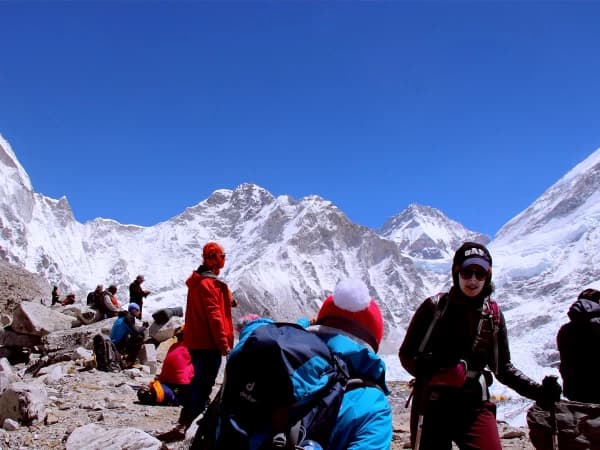
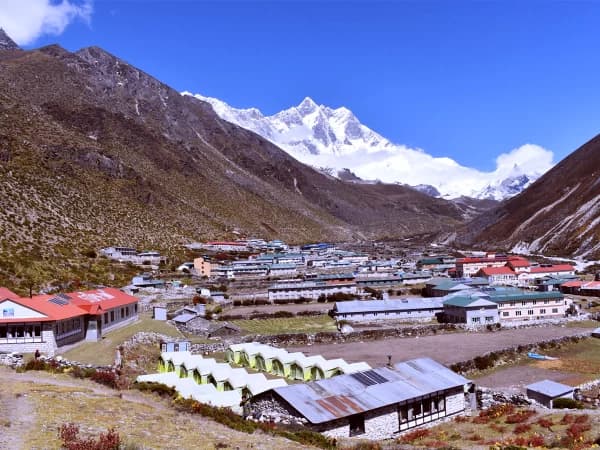
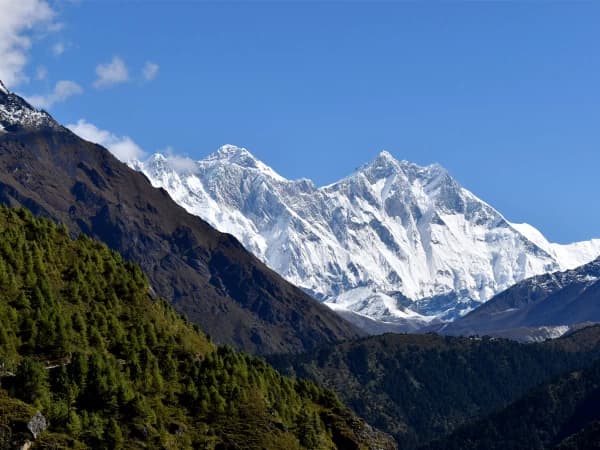

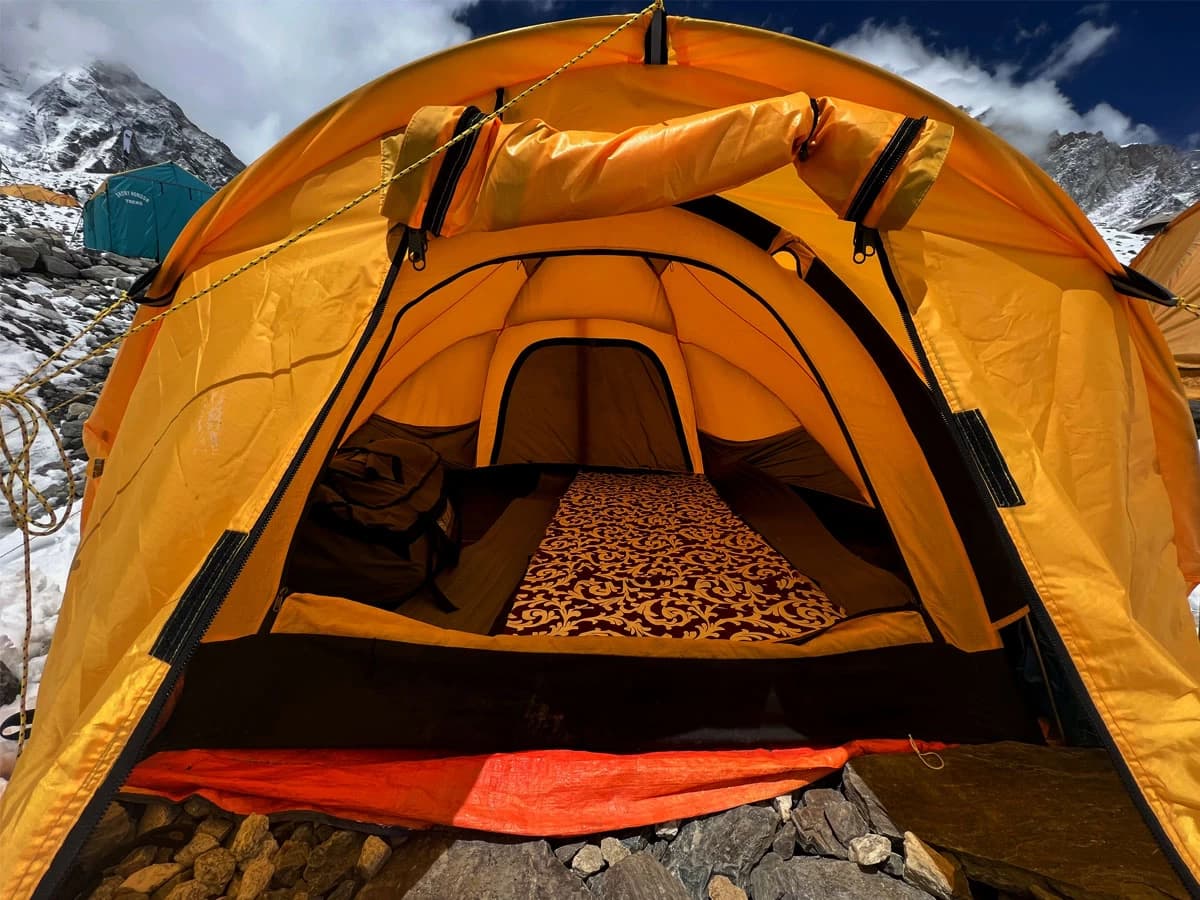
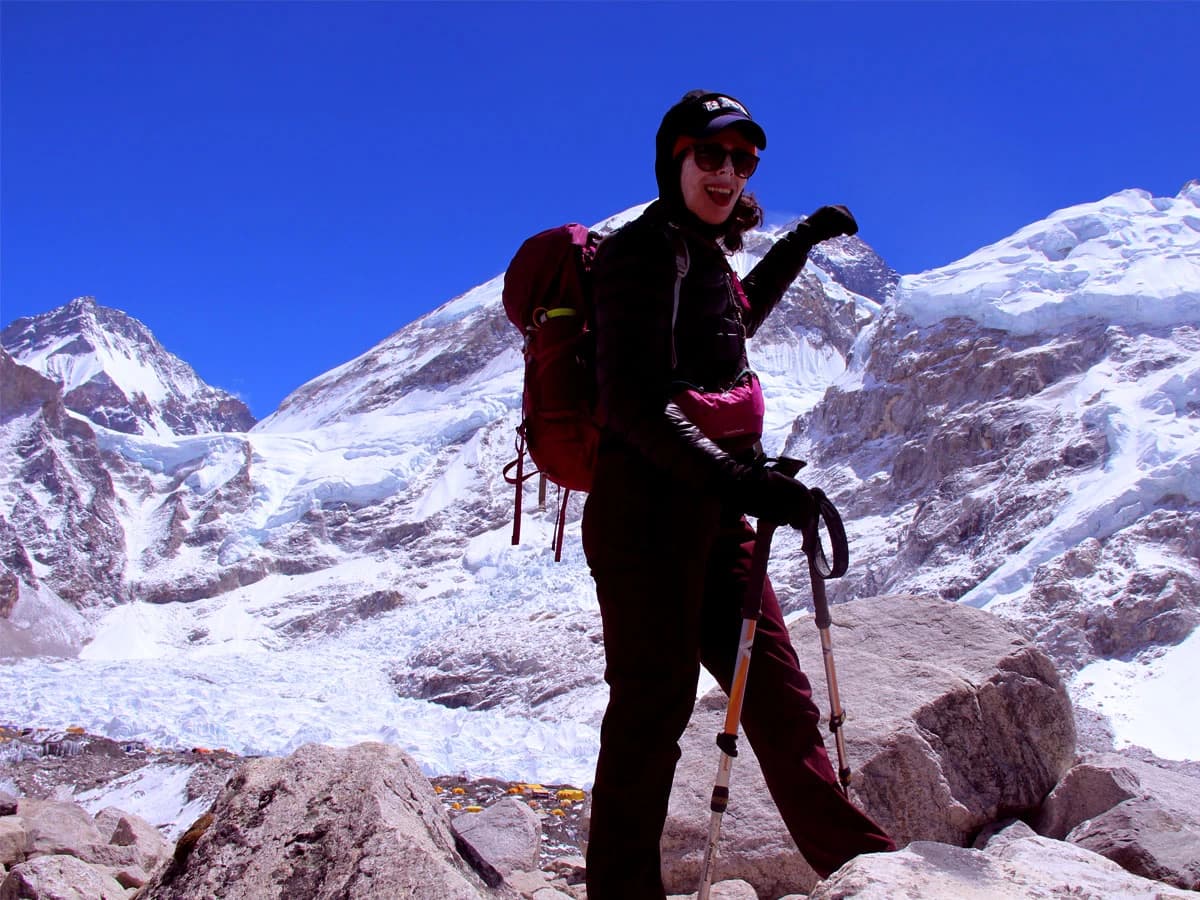
Essential Information
Best Time for High-altitude Everest Overnight Trek
The High-altitude Everest Overnight Trek is a dream adventure for many trekkers, and picking the right time to go can make all the difference. To get the most out of your experience, it’s best to plan your trek during the right season. Spring and autumn are the top times to visit because of the great weather and beautiful views.
a. Peak Season Options (Pleasant Weather, Crowds)
Spring (March - May): Spring is one of the busiest and best times to take the Everest Base Camp Overnight Trek. The days are usually sunny, with clear skies and mild temperatures. The trails are colorful, with rhododendrons in bloom, adding to the beauty of your trek. If you want to catch the best weather, aim for the middle of the season when the views are at their clearest.
Autumn (September - November): Autumn is another fantastic time to trek. The weather is cool, and the skies are mostly clear. The views of Mount Everest and nearby peaks are sensational. October is especially popular, offering perfect weather for a memorable trek. The trails also look vibrant after the monsoon rains, giving you a unique experience.
b. Off-Season Options (For Experienced Trekkers)
Winter (December - February): Winter brings a challenge for those looking for a more quiet and adventurous trek. It’s very cold, with temperatures sometimes dropping to -25.9°C at night, but the skies are often clear, and the area is peaceful. If you’re well-prepared for the cold, winter trekking can be an option for a lifetime experience.
Monsoon Season (June - August): The monsoon season is the least ideal for trekking. Heavy rains can make the trails slippery, and landslides may occur. The views can be blurred, but if you’re looking for peace and a unique experience, it’s still an option - though it’s best for seasoned trekkers.
c. Key Considerations
Weather: For the best views, choose a season with clear skies and stable weather.
Crowds: If you’d rather avoid crowds, consider trekking in the off-season, early spring, or late autumn.
Temperature: Spring and autumn are milder, while winter can be very cold. Pick the season that best suits your comfort level.
Festivals: Be mindful of major Nepali festivals like Dashain (September/October), which might impact your travel or costs.
Booking: If you’re trekking during peak seasons, it’s a good idea to book your trek and accommodations early, especially during festival times.
Note: Even during the best seasons, weather can be unpredictable. Make sure to pack accordingly and be ready to adjust your plans if needed for a safe and comfortable trek.
Essential Things You'll Need for Your EBC Sleeping Trek
Here are some things to remember to make your Everest Base Camp Trek as smooth and enjoyable as possible:
a. Visa: Almost everyone (except Indian citizens) needs a visa to visit Nepal. You can get one when you arrive at the airport in Kathmandu. Here are some things to keep in mind:
- Make sure your passport is valid for at least 6 months.
- Bring one passport-sized photo.
- There's usually a fee for the visa, around $50 for a 30-day stay.
- For the latest information on visas, you can visit the Nepal Immigration website.
b. Travel Insurance: This is super important, especially for climbing the Everest Base Camp. Make sure your insurance policy covers medical expenses, evacuation, and helicopter rescue up to 6,000 meters. Double-check with your insurance company to make sure everything is covered.
c. Currency Exchange: The currency in Nepal is the Nepali Rupee (NPR). It's best to bring widely accepted currencies like USD, EUR, or GBP and exchange them at banks or money exchangers. There are also ATMs in Kathmandu, but they might have limits on how much money you can withdraw and charge extra fees. Make sure your cash is clean and not ripped, as torn notes may not be accepted.
d. Extra Spending Money: There will probably be some things you want to buy or do that aren't included in your trek package. This could include accommodations in Kathmandu before or after your trek, your visa, travel insurance, snacks, drinks (both hot and cold), Wi-Fi access, hot showers, and tips for your porters. You should budget around $10 to $20 per trekking day for these additional expenses.
By planning ahead and bringing everything you need, you can relax and focus on enjoying your amazing EBC Trek adventure.
Meals and Accommodation During the Everest Base Camp Sleeping Trek
The Everest Base Camp Overnight Trek Package ensures you stay nourished and well-rested throughout your adventure, whether you're trekking.
i. Meals on the Trek
You’ll enjoy three wholesome meals daily, featuring a mix of local and international dishes:
Breakfast: You’ll start your day with options like pancakes, porridge, chapati, eggs (boiled, scrambled, or in an omelet), hash brown potatoes, and toast.
Lunch and Dinner: Meals include local favorites like Dal Bhat (a filling dish of rice, lentil soup, and curry) and Sherpa stew, along with pasta, noodles, fried rice, and seasonal vegetables. Dinner often comes with warm soups like tomato, garlic, or mushroom soup to keep you cozy.
Drinks: Refreshing drinks such as black tea, ginger tea, lemon tea, and milk coffee are available. Staying hydrated is essential, so aim to drink plenty of fluids and avoid alcohol or fizzy drinks to reduce the risk of altitude sickness.
ii. Accommodation During the Trek
During the Everest Trek with an Overnight at EBC, you’ll stay in cozy mountain lodges and teahouses with basic facilities. Rooms are typically shared between two trekkers and include a bed, blanket, and pillow. Some lodges offer hot showers, Wi-Fi, and electric blankets, though these services may be limited at higher altitudes.
At the Everest Base Camp, you’ll sleep in tented camps equipped with mattresses and other essential comforts to help you. However, in Kathmandu, you’ll enjoy a comfortable stay at a 3-star hotel with modern amenities. Options for luxury or budget accommodations are also available, based on your preference.
iii. Tips for Trekkers
Food options may become more limited and expensive at higher elevations, so consider bringing your favorite snacks or energy bars for the trek.
Drink plenty of water, tea, and soup to stay hydrated during the high-altitude Everest Overnight Trek.
Everest Base Camp Difficulty: What to Expect?
The EBC Trek with Overnight at Base Camp is a rewarding adventure, but it does come with challenges. Each day, you’ll trek for about 4 to 7 hours, walking through hills, rocky trails, and uneven terrain. You’ll cross rivers on suspension bridges and climb steadily toward higher altitudes.
The Everest Overnight Trek requires good physical fitness, as trekking at high altitudes can be demanding. The thinner air and steep paths may test your stamina, but with proper preparation, it’s achievable for most adventure seekers. Taking rest days for acclimatization at Namche Bazaar and Dingboche is key to helping your body adjust to the altitude.
The trek to Everest Base Camp isn’t about speed; it’s about pacing yourself and enjoying the journey. Carrying a daypack with essentials, such as warm clothing and water, is necessary, but porters will help with heavier loads, making the trek more manageable.
Spending a night at Everest Base Camp is a highlight of this Everest Base Camp Overnight Trek Package. It’s a unique experience that combines physical challenges with the breathtaking beauty of the Himalayas. This unforgettable adventure is open to beginners with basic trekking experience, as long as you’re prepared for the EBC Sleeping Trek’s demands.
The High-altitude Everest Overnight Trek doesn’t require technical climbing skills, but being in good health is essential. If you have any concerns about your fitness or health conditions, it’s always a good idea to consult a doctor before starting this journey.
With proper preparation, guidance from experienced trek leaders, and the right mindset, the Everest Trek with Overnight at EBC is an incredible adventure that rewards you with memories to last a lifetime.
Exploring the Wilderness of a UNESCO World Heritage Site
The trail to Everest Base Camp takes you through Sagarmatha National Park, a UNESCO World Natural Heritage Site known for its breathtaking landscapes and rich biodiversity. From Monjo onwards, you’ll trek through this stunning park, home to unique plants and animals that thrive in its varied climates.
As you journey through the park, you’ll walk along forested trails, cross clear mountain streams, and navigate rolling hills. The beauty of the surrounding wilderness is matched only by the spectacular views of towering peaks like Lhotse, Cho Oyu, Pumori, Ama Dablam, Thamserku, Kwangde, Kangtaiga, and Gyachyung Kang.
Every step in this pristine environment brings you closer to the heart of the Himalayas, making the journey to Everest Base Camp a truly unforgettable adventure.
Sleeping at Everest Base Camp Trek Equipment List
FAQs
It's a moderately challenging trek due to high altitude and daily hikes of 6 to 7 hours. No technical climbing is needed, but stamina and mental readiness are required.
Focus on cardiovascular endurance, hill training, and strength exercises. Hiking at high altitudes and carrying a backpack during training is recommended.
Previous hiking experience is helpful but not necessary. Good physical condition and preparation for high altitude challenges are important.
We prioritize the safety and comfort of all travelers, including women. We provide secure accommodations with private rooms and tents, and our experienced guides ensure your journey is safe and enjoyable.
Two acclimatization days are included: one at Namche Bazaar and another at Dingboche. These help adjust to the altitude.
Yes, altitude sickness is a concern. Proper acclimatization days and a slow, steady pace help reduce the risk.
If you've booked a package, most expenses are covered. Expect to spend around USD 20 to 30 per day for extras like snacks and device charging.
You'll need the Sagarmatha National Park Permit, TIMS Card, and the Khumbu Pasang Lhamu Rural Municipality Permit, which can be obtained in Lukla.
Spending a night at Everest Base Camp, seeing the Khumbu Glacier, and enjoying sunrise views of Everest from Kala Patthar.
No, the summit isn’t visible from Base Camp, but you can see it from Kala Patthar and on the trail near Namche Bazaar.
The highest point is Kala Patthar at 5,545 meters (18,514 feet).
The EBC Sleeping Trek lets trekkers spend a night at Everest Base Camp under a starry sky, unlike the regular trek. It also includes exploring the Khumbu Icefall.
Yes, you will stay at Everest Base Camp in designated tents. You'll observe climbers and enjoy fresh meals prepared on-site.
Yes, nutritious meals including Nepali, Tibetan, and Western options are provided.
Most nights are spent in tea houses with basic facilities. At Everest Base Camp, you'll stay in tents managed by experienced guides.
Your guides are experienced, full-time local experts fluent in English with extensive knowledge of the Everest region and its culture.
A licensed guide is required by Nepalese regulations. Hiring a porter is recommended for a more comfortable trek.
No, climbing gear is not required. Basic hiking essentials like sturdy trekking boots, poles, warm clothing, and a sleeping bag are needed.
Weather varies by season. Spring and autumn offer clear skies and moderate temperatures, while higher altitudes can be very cold.
There’s no strict age limit, but good physical and mental health is necessary. Trekkers usually range from 16 to 70 years old.
I. Expertise and Local Knowledge
When you book the trek with Himalayan Massif Trek, you're choosing a team of experienced guides who have in-depth knowledge of the Everest region. The guides are locals who know the culture, terrain, and trails better than anyone else. With decades of trekking expertise in the Himalayan belt, they will ensure you have a safe and enriching journey throughout your trek.
II. Authentic Local Experiences
We offer you the chance to experience authentic Sherpa villages like Namche, Dole, and Machhermo. Along the way, you'll enjoy traditional Sherpa meals, providing you with a true taste of local culture. You’ll also gain insights into the traditions, lifestyle, and hospitality of the people from the Everest region. Hence, this makes your trek feel like more than just a hike - it’s a cultural adventure.
III. Value for Money
Great value for money is another reason you should book your Gokyo Lakes Trek with Himalayan Massif Trek. We offer competitive prices with no hidden costs. Everything is included, from your permits and comfortable accommodations to your delicious meals. Plus, we have special discounts for groups and repeat travelers.
IV. Environmental Responsibility
Our company is committed to environmental responsibility, ensuring that trekking in the Everest region has minimal impact on the environment. By using eco-friendly trekking practices and supporting local suppliers, we help preserve the beauty of the Himalayas. We also, prioritize sustainable travel, assuring that local communities and the stunning landscape remain protected for future generations.
- Expertise in High-Altitude Trekking Adventures
- Over 18 Years of Experience in The Himalayas
- Authorized and Reliable Trekking Partner
- Trusted by Thousands of Adventurers Worldwide

The overnight stay at EBC was the highlight of the trip. The trek itself was well-organized, and the guides were fantastic. The team made sure...
This trek was everything I hoped for and more. The overnight stay at EBC was a once-in-a-lifetime experience. The team was professional and supportive throughout...
Spending a night at Everest Base Camp was surreal. The trek was challenging but incredibly rewarding. The team at Himalayan Massif Trek made sure we...
